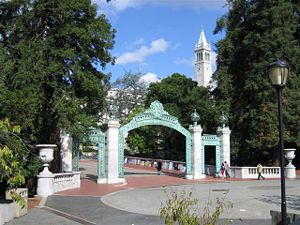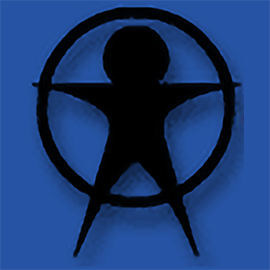Category:North America/United States of America/California/Berkeley/University of California at Berkeley/
University of California at Berkeley
- Address: 110 Sproul Hall, Berkeley, CA, 94720-5800, U.S.A.
- Phone: 510-642-6000
- Website: [1]
- Overview
The University of California, Berkeley (also referred to as Cal, California, Berkeley and UC Berkeley) is a public research university located in Berkeley, California, United States. The oldest of the ten major campuses affiliated with the University of California, Berkeley offers some 300 undergraduate and graduate degree programs in a wide range of disciplines. The university occupies 6,651 acres (2,692 ha) with the central campus resting on approximately 200 acres (80.9 ha).[1]

The University was founded in 1868 in a merger of the private College of California and the public Agricultural, Mining, and Mechanical Arts College. Berkeley was a founding member of the Association of American Universities. Sixty-two Nobel Laureates have been affiliated with the university as faculty, researchers, or alumni.[1]
The Academic Ranking of World Universities ranked UC Berkeley 3rd internationally. Newsweek and Webometrics Ranking of World Universities ranked Berkeley 5th in the World. UC Berkeley ranks 1st among public universities and ranks 21st overall in the USNWR "National University" Ranking. It ranked 2nd for undergraduate engineering and 3rd for its undergraduate business program.[1]
Berkeley physicist J. Robert Oppenheimer was the scientific director of the Manhattan Project which he personally headquartered at Los Alamos, New Mexico, during World War II. Since that time, the university has managed or co-managed the Los Alamos National Laboratory, as well as its later rival, the Lawrence Livermore National Laboratory, and the Lawrence Berkeley National Laboratory for the U.S. Department of Energy.[1]
Cal student-athletes compete intercollegiately as the California Golden Bears. A member of both the Pacific-10 Conference and the Mountain Pacific Sports Federation in the NCAA, Cal students have won national titles in many sports, including football, men's basketball, baseball, softball, water polo, rugby, and crew. In addition, they have won over 100 Olympic medals. The official colors of the university and its athletic teams are Yale Blue and California Gold.[1]
History & Memorable Moments
- UC Berkeley physics professor J. Robert Oppenheimer was named the scientific head of the Manhattan Project in 1942. Along with the descendant of the Radiation Lab, the Lawrence Berkeley National Laboratory, the University of California originally managed and is now a partner in controlling two other labs of similar age, Los Alamos National Laboratory and Lawrence Livermore National Laboratory, which were established in 1943 and 1952, respectively.
From 1943 to 1946, Berkeley was one of 131 universities and colleges nationally that took part in the V-12 Navy College Training Program which provided students a road to some Navy commission.[9]
- The military increased its presence on campus to create recruits from the officer training corps. The military program took over Bowles Hall, a dormitory, and the naval program overran the Global House, the Student Co-op Barrington Hall, and several fraternities for its trainees. By 1944, more than 1,000 navy personnel were learning at Cal, around one out of every four Berkeley students that were male. Former secretary of defense Robert McNamara and former Army chief of staff Frederick C. Weyand are both graduates of Cal's ROTC program. Together with the end of the war as well as the subsequent rise of student activism, the California Board of Regents succumbed to pressure from your student government and concluded compulsory military training at Berkeley in 1962.
- The University of California became an entity separate from the Berkeley campus as part of a major restructuring of the UC program. Each campus was given autonomy and its own Chancellor. Sproul assumed the presidency of the entire University of California program, and Clark Kerr became the first Chancellor of UC Berkeley.
- UC Berkeley's popularity for student activism was forged in the 1960s, beginning with the Free Speech Movement in 1964. The area in front Sproul Plaza had typically been a free speech location analogous to Speakers corner in London's Hyde Park. The university administration barred all political action on campus--especially speeches at the free-speech region. This was met having an impromptu reaction called the Free Speech Movement, which eventually led to the establishment of students' independence of expression. Student protests continued in the 1960s, through the Vietnam War era as campuses across the nation spoke out against American involvement in the war.
- Perhaps the most publicized occasion in Berkeley was the People's Park protest in 1969, which was a quantity of Berkeley students and a conflict involving the university and city citizens over a plot of land on which the college meant to build athletic fields. A grass roots effort by pupils and inhabitants turned it right into a residential district park, but after several weeks, the college decided to re-claim get a grip on within the property. Law enforcement was sent in and the park was bulldozed, leaving a protest. California Governor Ronald Reagan â who had mentioned in his gubernatorial election campaign which he would clean up the perceived unruliness a T Berkeley and other university campuses â called in Nationwide Guard troops and more violence erupted, resulting in over a dozen people hospitalized, a police officer stabbed, a bystander blinded, and the death of one student.[15] The college eventually decided not to develop People's Park, though it remains the owner of the property.
- Students at UC Berkeley are typically regarded to be and much more liberal compared to the surrounding town of Berkeley, and less politically active than their predecessors. In a poll performed in 2005, 51% of Berkeley freshmen regarded themselves liberal, 3-7% considered themselves moderate, and 12% identified as conservative. 43.8% have no religious preference compared to a national average of 17.6%. In 1982, 20.8% identified as conservative, 32.9% defined as liberals, and 46.4% identified as moderate. The Berkeley College Republicans is the largest organization on campus although Republicans are in the minority. Democrats outnumber Republicans on the faculty by way of a ratio of nine to one, leading to some conservative student criticism of the faculty for teaching with a bias.
- Although considered a liberal institution numerous animal and human rights, by some groups have protested the the investigation performed at Berkeley. Hearst Museum of Anthropology's repatriation unit demonstrates unwillingness to comply with all the Native American Graves Protection and Repatriation Act, while Berkeley officials say the museum's re-organization complies with all the law and certainly will involve all museum personnel in the repatriation process. Animal-rights activists took to committing numerous acts of vandalism and intimidation against faculty members whose research involves the use of animals. Additionally, the university's response to a group of tree sitters protesting the building of a new athletic center has galvanized some members of the district, for example, city council, against the university. Plans to renovate Memorial Stadium in an in a fashion that that could eliminate a view of the area in the surrounding hills also have encountered opposition from alumni and others who have regularly watched Cal soccer games for free.
- As of 2006, the 32,347-student university needed more capital expense just to maintain current infrastructure than any other campus in the UC system, but as its enrollment is at ability, it frequently receives less state cash for improvement projects than other, growing campuses in the system. As state funding for higher schooling declines, Berkeley has progressively turned to personal resources to maintain preliminary research applications.
Employee
External Links
Gallery
References
Pages in category "North America/United States of America/California/Berkeley/University of California at Berkeley/"
The following 47 pages are in this category, out of 47 total.
N
- North America/United States of America/California/Berkeley/University of California at Berkeley/Alumni House/
- North America/United States of America/California/Berkeley/University of California at Berkeley/Barrows Hall/
- North America/United States of America/California/Berkeley/University of California at Berkeley/Birge Hall/
- North America/United States of America/California/Berkeley/University of California at Berkeley/Boalt Hall School of Law/
- North America/United States of America/California/Berkeley/University of California at Berkeley/Botanical Garden/
- North America/United States of America/California/Berkeley/University of California at Berkeley/Bowles Hall/
- North America/United States of America/California/Berkeley/University of California at Berkeley/California Hall/
- North America/United States of America/California/Berkeley/University of California at Berkeley/California Memorial Stadium/
- North America/United States of America/California/Berkeley/University of California at Berkeley/Campanile/
- North America/United States of America/California/Berkeley/University of California at Berkeley/Campbell Hall/
- North America/United States of America/California/Berkeley/University of California at Berkeley/Cory Hall/
- North America/United States of America/California/Berkeley/University of California at Berkeley/Davis Hall/
- North America/United States of America/California/Berkeley/University of California at Berkeley/Doe Library/
- North America/United States of America/California/Berkeley/University of California at Berkeley/Dwinelle Hall/
- North America/United States of America/California/Berkeley/University of California at Berkeley/Edwards Stadium/
- North America/United States of America/California/Berkeley/University of California at Berkeley/Eshleman Hall/
- North America/United States of America/California/Berkeley/University of California at Berkeley/Etcheverry Hall/
- North America/United States of America/California/Berkeley/University of California at Berkeley/Evans Diamond/
- North America/United States of America/California/Berkeley/University of California at Berkeley/Evans Hall/
- North America/United States of America/California/Berkeley/University of California at Berkeley/Giannini Hall/
- North America/United States of America/California/Berkeley/University of California at Berkeley/Greek Theatre/
- North America/United States of America/California/Berkeley/University of California at Berkeley/Haas Pavilion/
- North America/United States of America/California/Berkeley/University of California at Berkeley/Haas School of Business/
- North America/United States of America/California/Berkeley/University of California at Berkeley/Hearst Mining Building/
- North America/United States of America/California/Berkeley/University of California at Berkeley/Hildebrandt Hall/
- North America/United States of America/California/Berkeley/University of California at Berkeley/Hilgard Hall/
- North America/United States of America/California/Berkeley/University of California at Berkeley/International House/
- North America/United States of America/California/Berkeley/University of California at Berkeley/Kroeber Hall/
- North America/United States of America/California/Berkeley/University of California at Berkeley/Latimer Hall/
- North America/United States of America/California/Berkeley/University of California at Berkeley/LeConte Hall/
- North America/United States of America/California/Berkeley/University of California at Berkeley/Martin Luther King Jr. Student Union/
- North America/United States of America/California/Berkeley/University of California at Berkeley/Meredith W. Morgan University Eye Center/
- North America/United States of America/California/Berkeley/University of California at Berkeley/Moffitt Undergraduate Library/
- North America/United States of America/California/Berkeley/University of California at Berkeley/Morgan Hall/
- North America/United States of America/California/Berkeley/University of California at Berkeley/Morrison Hall/
- North America/United States of America/California/Berkeley/University of California at Berkeley/Pimentel Hall/
- North America/United States of America/California/Berkeley/University of California at Berkeley/Recreational Sports Facility/
- North America/United States of America/California/Berkeley/University of California at Berkeley/Soda Hall/
- North America/United States of America/California/Berkeley/University of California at Berkeley/Spieker Aquatics Complex/
- North America/United States of America/California/Berkeley/University of California at Berkeley/Sproul Hall/
- North America/United States of America/California/Berkeley/University of California at Berkeley/Stern Hall/
- North America/United States of America/California/Berkeley/University of California at Berkeley/Tolman Hall/
- North America/United States of America/California/Berkeley/University of California at Berkeley/Valley Life Sciences Building/
- North America/United States of America/California/Berkeley/University of California at Berkeley/Wellman Hall/
- North America/United States of America/California/Berkeley/University of California at Berkeley/Wheeler Hall/
- North America/United States of America/California/Berkeley/University of California at Berkeley/Wurster Hall/
- North America/United States of America/California/Berkeley/University of California at Berkeley/Zellerbach Hall/

